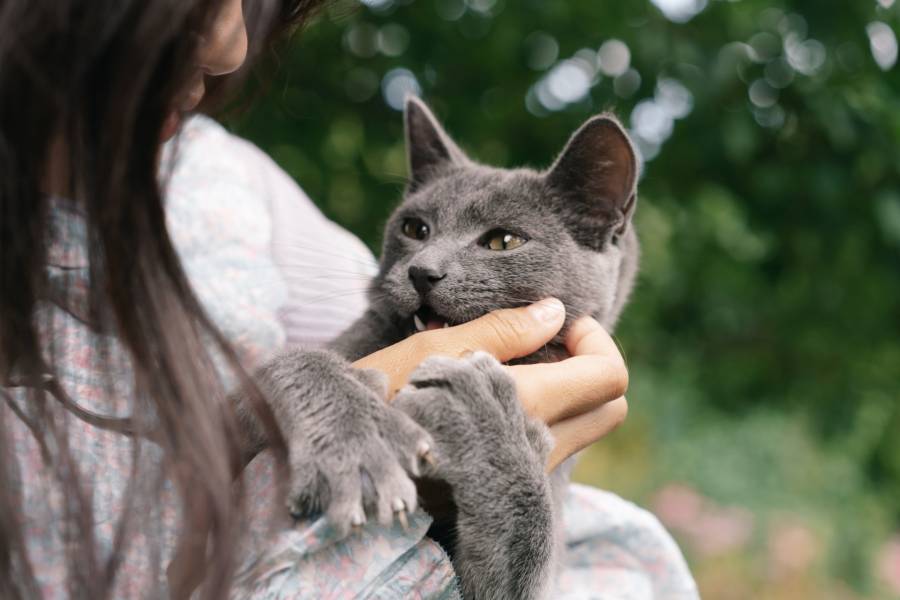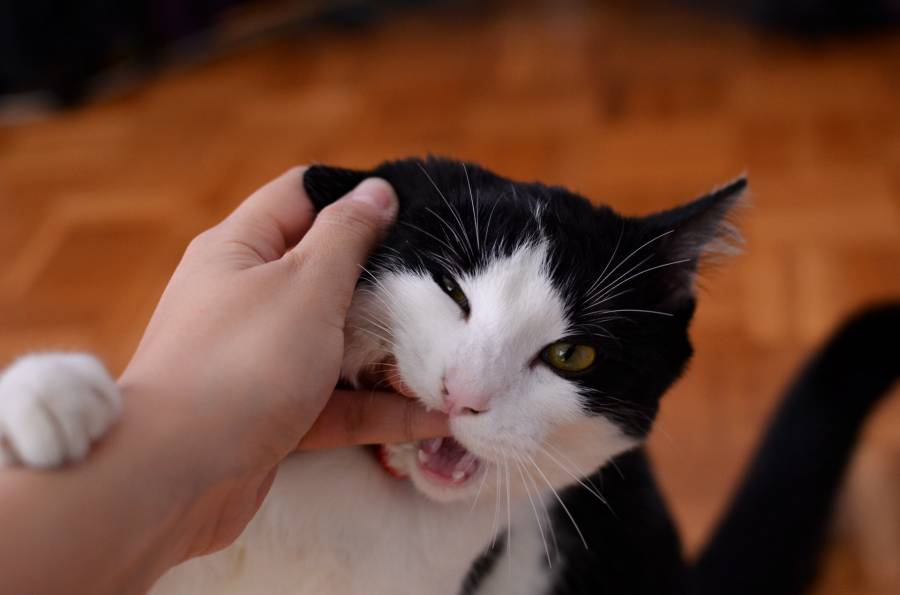Quick Navigation
Have you ever asked, “Why does my cat hug my arm and bite me?”
The sudden cat bites on their hands or fingers while hugging them are familiar to most cat owners.
Cats might seem to be enjoying being petted by bursting a purr.
However, they can hug the owners’ arms and unexpectedly bite down on the owners’ hands.

This can leave many cat owners frustrated and in pain from the bites of their furry feline.
Some people refer to these bites as ‘love bites,’ but the induced aggressive look on the cats’ faces might suggest otherwise.
Regardless, it is essential to know what these bites mean.
Reasons Why Cats Hug Pet Owners’ Arm And Bite Them
1. Overexcitement
The feeling of being comforted and petted by their owners can be exhilarating for cats.
While petting, the strokes are usually calm initially, and the intensity might increase while listening to the cats’ purr.
And it may either change the cat’s or the owner’s mood.
In the heat of the moment, the cat can become restless when the stroke intensity increases.
The cat can hug the owners’ arms and nibble on the hands in reaction to the excitement.
2. They Feel Satiated
Petting can increase cats’ stimulation, and the longer the petting duration, the greater the buildup of stimulation.
This significant buildup of stimulation can be too much for a cat to contain, eventually becoming uncomfortable.
Different cats have different levels that can contain the buildup of stimulation.
That is why some cats can be petted for longer than others.
Cats can also be satisfied after petting for a while, and any more petting after this period will irritate them.
Cats have sensitive skin, and petting for a long duration can result in stimulus habituation.
It is when the sensation and the buildup of stimulation decrease after petting for long periods.
When cats hug the arms and bite the hands, it shows that they are satisfied and are done with the interaction.
When To Stop Petting
Most times, your cat could get irresistible.
Therefore, you must know how your cat responds whenever you pet it.
Watch for signs of discomfort.
Your cat may show you through its ears by bringing them to its side.
It also twitches or flicks its tail when it has enough. So if you begin to see these signs, you must stop petting your cat.
3. Grooming Technique
Cats are susceptible to the environment, and they groom themselves excessively.
It is done to regulate their body temperature and make them comfortable.
Sometimes when they feel the stroke of the owner’s hand, they lick the hands to groom the owner.
It could even be when the cat isn’t being petted; it can lick the owner’s face or feet.
When cats are being petted, they sometimes hug the arms and lick the hands as part of the grooming process.
The teeth can get in the way of the cats’ tongues and bite the owners’ hands during the process.
4. They Feel Aversed
Even though cats nibble and bite while being petted, this is not always the case.
There are cases when a cat’s bite could mean:
- They do not like to be petted at the moment.
- They are uncomfortable with the parts of the body being touched.
- They do not like the way they are being carried or held.
The cat will most likely not waste time biting the owner’s hand if it does not want to be petted.
Some cats feel uncomfortable when they are carried or held, while others are uncomfortable when unusual places are petted and may feel averse.
Moreover, they can hug the arms and bite the hands to avoid being touched in those areas.
Unusual parts could include the belly area, the tail, and the limbs.
Safe places to pet a cat would be the back of the head, the chin, and the cat’s back.
5. Affection
Extensive physical contact means the cat feels comfortable, and one of the ways cats reciprocate this feeling is by showing affection.
One of the ways cats do show affection is through their body language.
This includes the hug of arms and licking of hands or fingers.
It is also one of the ways a cat’s mother shows affection to her kittens.
Doing this also indicates that the cat is creating a social bond.
Their ancestors and cat family members are also known for showing affection and creating bonds with themselves.
The cat’s bite might not be intentional, or it could be purely accidental.
This shows that the cat is comfortable and intends to ensure mutual feelings.
6. Playtime
Sometimes the contact is initiated by cats.
The cat could initiate contact by attempting to hug the owner’s arm.
This is usually a signal that the cat requires attention.
Cats that don’t have a lot of toys to play with will likely end up using the owner as a play toy.
That is, if there are no objects in the vicinity to toy with.
Cats use their vicious claws and teeth when playing with toys.
When there are no objects to interact with, the cat could use these weapons on the owner’s arm.
The hugging and biting of hands can be cats just having fun.
However, if this behavior is encouraged in kittens, it’ll certainly escalate, if not discouraged, when the cat is grown up.
7. Redirect The Attention
A cat’s meow may be to seek attention from something else, or it could just be a cry out for help.
However, they can be ignored often because we don’t understand them.
Hugging arms and biting hands or fingers can redirect the owners’ attention.
The cat could walk up to the owner’s leg or right in front to seek attention.
If the arms are accessible to the cat, the cat could hug the arms and softly bite on the hands to gain the owners’ attention.
8. Test Their Dominance
Cats are territorial animals by nature, just like most animals.
From time to time, cats do tend to exert their dominance to determine who the boss is.
The reaction the cat receives determines if the will to exert dominance increases.
The test of dominance can happen without even knowing it.
It could happen while feeding, claiming a spot to sleep, or just petting the cat.
When they bite the hands or fingers, the reaction to cats should be carefully taken.
Otherwise, the cat could express aggressive behavior if the situation is not handled with caution.
9. Predatory Instinct
Biting is an instinct in cats that comes naturally.
One of the reasons why cats love to bite and chew on objects is boredom.
In addition, one of the ways to kill boredom is to claw in, bite and chew on objects.
The cats’ willingness to play with the object will depend on the object.
The items can range from leather or cotton fabrics, wire or cords, and houseplants or twigs.
Cats do tend to chew on objects when they are bored.
Moreover, play toys should be available for the cat to chew and bite on.
Otherwise, the cat could resort to hugging the owners’ arms and biting the hands or fingers to kill the boredom.

10. Hunger
Another reason cats hug their owners’ arms and bite their hands is that they are hungry.
Although this case is rare, they are entirely possible.
The site may not always occur at the hands; they can also bite slightly hard on the feet.
To rule out the possibility of hunger, ensure the cat has been fed.
11. Hostile
This scenario mainly applies to cats (grown kittens), especially stray cats.
Some cats that aren’t used to being petted will have difficulty feeling comfortable enough to be petted.
This is because these cats tend to feel threatened a lot.
Moreover, if cats are petted by someone they aren’t comfortable with, they can hug the person’s arm and bite in reaction.
12. Injury
Like any other injured animal, cats sustain either minor or major injuries.
When they do sustain injuries, they try their best to hide them.
It is also one of the things passed down by their ancestors; otherwise, predators will sense they have been injured.
If injured, cats should not be touched on parts of the body that have sustained injuries.
Otherwise, they can hug the owner’s arm and bite the hand in reaction to the pain.
How Will I Know if It Is Just a Love Bite?
Often, your cat would hug your arm and bite you out of petting-induced aggression.
If it is just a cat love bite, your cat’s teeth won’t cut your skin, although you may feel its teeth against your arm or wherever it bites you.
Unlike your cat’s aggressive biting, typically associated with fear and self-defense, your cat won’t growl, hiss, and claw at you when it’s simply doing a love bite.
It may even have a relaxed posture and a friendly warmth.
However, when your cat’s teeth accidentally cut you during a love bite, especially if it’s a kitten with sharp teeth, ensure to wash your wound with soap and water.
Summary
Cats do not necessarily need to be petted constantly.
It is because of their feline nature.
In addition, the reason why cats hug their owners’ arms and bite them does vary.
One of the main reasons why they bite is that they are overstimulated.
In addition, constant petting can lead to stimulus habituation, where the cat no longer feels stimulated because of prolonged petting.
It can irritate the skin, and the cat can bite down on the hands and fingers.

A passionate content creator on pet behavior, nutrition choices, and health, Mike is an experienced pet expert. He has been writing on multiple websites to compensate for his passion for cats. Mike grieves around plenty of pets in his parents’ house. At the start of his career, he had a sturdy intention to be a part of pet care by any means.
With his affiliation to Purrfect n’ Pawesome, he found a way to satiate his craving to participate in pet health, wellness, and behavior analysis. He has been a significant part of our team and a major contributor in equipping our site with useful, authentic, and research-backed articles.
“I love pets as much as I love to travel to explore multiple places and lifestyles. I have been attached to this pawsome platform for many years, and my experience regarding pets has enhanced significantly by using various devices to write articles. I believe in writing my thoughts and experiences, so I try to write down the experience and learnings for my readers no matter where I am and what my mood is.”



![Why Does My Rabbit Bite My Clothes? [9 Reasons] Why Does My Rabbit Bite My Clothes? [9 Reasons]](https://purrfectnpawesome.com/wp-content/uploads/2021/08/Why-do-rabbits-bite-your-clothes-150x150.jpg)